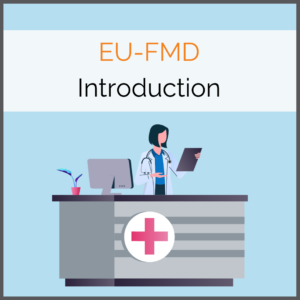
In pharmacies, hundreds of medicines are sold every day. From 9 February 2019, all prescription drugs must be serialized. So what does the Falsified Medicines Directive (FMD) mean for pharmacies and their internal processes?
Pharmacies usually purchase their medicines from wholesalers, where individual packagings can be checked optional. In the pharmacy every single medicine pack is then scanned, it is the very last verification and represents the end of the supply chain. The pharmacist scans the 2D data matrix code on the drug packaging and the pharmacy system automatically makes a verification request to the database system of the pharmaceutical industry. If the request is successful and everything is in order with the requested serial number, the pharmacy receives the “go-ahead“. The packaging is then verified and handed over to the patient as usual. If the serial number is not found in the system or there is any other error, the system displays “red“, and the medicine must not be handed out but is reported to the authorities.
New scanners and a new system for pharmacies
To comply with the Falsified Medicines Directive and to be able to handle the serialized drugs in compliance with the guidelines, pharmacies were equipped with the appropriate hardware and software by their pharmacy suppliers. The connection to the pharmacy system already began in 2018 to be able to resolve possible problems in good time before the final implementation of the Falsified Medicines Directive. The electronic access to the German verification system securPharm is called N-Ident and is made available to all public pharmacies by the Netzgesellschaft Deutscher Apotheken (NGDA), the network company of pharmacies in Germany. N-Ident consists of a user name, a password, and an electronic certificate. Furthermore, pharmacies also need a scanner that is compatible with securPharm. These preparations should already be completed at this moment in pharmaceutical serialization.
In ongoing businesses, the implementation of the Falsified Medicines Directive will mainly change the verification of medicines and a monthly fee of 10 euros plus VAT per business premises. Besides, the tamper-evident seal of each medicine pack must be checked to ensure that it has not been opened beforehand. It also makes sense for pharmacies to carry out the first verification as soon as the goods arrive. In this way, the merchandise management can be made more efficient, because batch descriptions and expiration dates are no longer entered manually but can be scanned together with the PZN. A further advantage is that non-deliverable drugs are detected early and in the absence of patients. However, the final verification takes place, as always, before the medicine pack is handed out to the patient. This is important because only then will the data be up to date and also, only in this way it is possible to comply with the legal requirements in which it is stated: The authenticity check must be carried out “at the time of delivery to the public.“
Partial quantities and other special cases
In everyday pharmacy life there are of course some special cases that must be taken into account in the new procedure. A special feature, for example, is partial quantities. They may continue to be dispensed, the corresponding medicine pack with the remaining quantity remains in the pharmacy and is only verified in the system after complete delivery. If the deactivation of the serial number via the pharmacy system is not possible due to the internet or power failure, the deletion can also be carried out later and manually. Besides, a 10-day reversing entry period is scheduled within which booked out drugs can be set “active“ again as long as they have not left the control area of the pharmacy, for example, the courier did not catch the patient.
All in all, pharmaceutical serialization can be seen as a positive development for pharmacies since – in addition to greater patient safety – batch numbers and expiration dates, as well as the assignment to the respective supplier, are now available in machine-readable form, thus making merchandise management more efficient.
And how are hospital pharmacies affected by serialization?